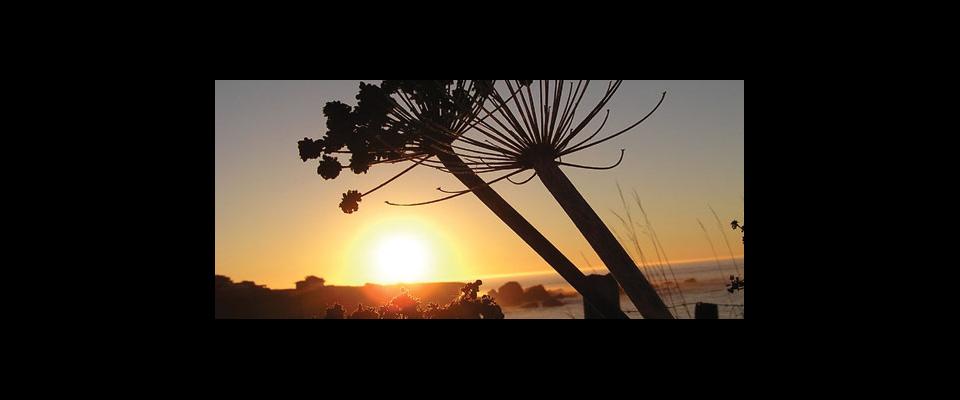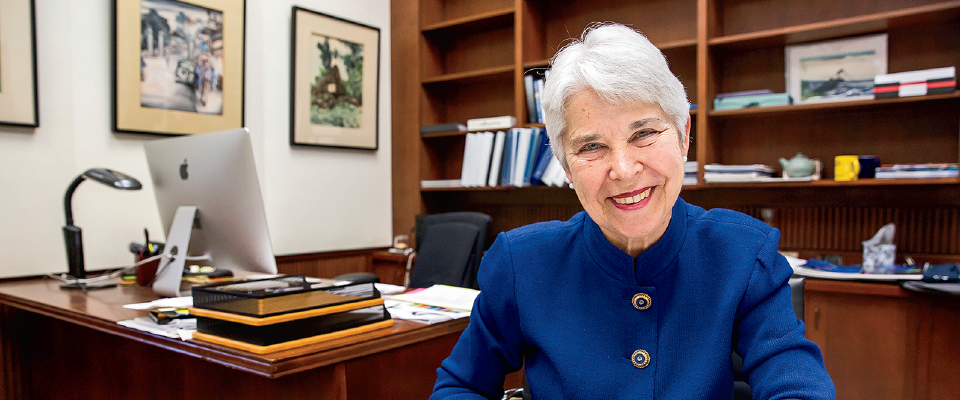A Berkeley planner helps a community sustain its town.
When 300 acres of the town of Caspar went on the market in 1997, a cluster of concerned residents shook off their cherished isolation and conspired to preserve the soul of their town. Caspar lies about 175 miles north of San Francisco on the Mendocino coast, and was once a robust lumber town. After the lumber mill closed in 1955, the community devolved into 500 or so hippies, artists, and back-to-the-landers living in homes formerly occupied by mill workers and their families. The new, independent-minded locals rallied together when threatened—like during the Redwood Summer fight of 1990 for old-growth redwoods and the Ocean Sanctuary battle in 1992 against offshore drilling. On these occasions Caspar was quite effective and developed an impressive “spoiler” reputation.
So when the Caspar Cattle Company in 1997 initiated the sale of a major chunk of the village, stretching from the beach, creek, and headlands to Highway One and beyond, residents were stirred up. The optimistic-minded viewed the situation as an opportunity; those with a darker view worried that the acreage might be developed into grand homes, fancy hotels, a campsite tent ghetto, or worse yet, a golf course.
The community members, by then a well-oiled fighting machine when it came to warding off development, hoped to preserve their identity and shape their future. But first they had to figure out what future they wanted. They invited in Randy Hester to come study Caspar’s options.
Randolph T. Hester Jr. is a Berkeley Professor of Landscape Architecture & Environmental Planning (LAEP). As a founder of the participatory design movement in landscape architecture, his life-work has involved the revival of towns and community spirit. He studied both sociology and landscape architecture in the 1960s and realized how profoundly connected the two disciplines are. Then he got involved in the civil rights movement and worked on a project in an African-American urban community in Raleigh, North Carolina, that was very different than the rural environment he had grown up in. He began to think, “There was a set of values that made people behave differently, some value of community that was different than what I knew.”
Soon thereafter, Hester did a project at his son’s daycare center in Cambridge. Shocked by the results of the initial parent survey, he decided to resurvey the parents, this time employing guided fantasy, asking them to answer the same questions while imagining the kind of daycare they’d want for their kids. Their answers were completely different than they had been at first. “It was like two different sets of people,” recalls Hester, “one that was status driven and one that was value driven.” He developed a 12-step process to facilitate the “community development perspective.” The essential step was to listen to the residents, and then listen some more, with the idea of getting the town to articulate its values. Thus the designer can “perceive the soul of the community” and the residents can “consciously choose their future.”
In 1980, Hester began teaching at Berkeley. He and his wife, Marcia McNally (also an adjunct professor at LAEP), were invited to help the town of Manteo, North Carolina, reinvigorate its depressed economy. Their first set of plans infuriated the people of Manteo. So Hester began to map their daily patterns and identify their valued places. When a city councilman saw the results, he was shocked that the drugstore and post office ranked higher than churches and schools. “That’s the sacred structure of Manteo,” he said, coining a phrase that’s become integral to Hester’s method. Hester is now convinced that articulating the values of the community is a process that works. “At the same time that you build the physical community,” Hester says, “you build a sense of community, and that is completely universal … getting people to express what they really value is applicable everywhere.”
When Caspar residents came together to discuss the real estate situation in 1997, a sense of community was gathering steam. They met in the home of Jim Tarbell and Judy Tarbell, MA ’69, who had moved to Caspar in 1987. Two writers for The Muppets, Jerry Juhl (who died in 2005) and his wife, Susan Juhl, moved in at the same time as the Tarbells, but they didn’t know anyone else in town. “We were hermits,” said Susan. “We’d drive rather than walk to get our mail because we didn’t want to meet any neighbors.” Even the Juhls got involved as people came together, but there was no leadership to move it forward, just a bunch of individuals wanting their viewpoints heard and afraid someone else might take power. The primary motivation to attend meetings, at first, was to make sure nothing bad happened. Fearing a tyranny of the majority, they decided not to vote but to work by consensus.
They soon got stuck. Where should the center of town be? What about the town square? So Judy asked, “What if we have someone come in from the outside?” The Tarbells had been friends with Hester and McNally since 1984, when they’d written a piece about small town tourism for the Tarbells’ Ridge Review magazine. And that’s how Randy Hester entered the scene, graduate environmental planning class in tow.
Hester always starts a project with listening one-on-one. He and his students (who handled most of it) did some 80 hours of listening to the individuals of Caspar. When asked what was sacred, Caspar’s answer was clear. “Caspar Creek and the beach were sacred. No question. Then that piece of the headlands, no question. And that little dippy duck pond that has no ecological value,” Hester said.
Though the invitation stemmed from conflict, what Hester recalls most strongly of his time there was Caspar’s impressive unity. “I think the reason they were as successful as they were in their early years,” says Hester, “was that they were so clear, almost unanimous, about what was most important to them.” As he commonly did, Hester had asked them about their ecological niche. “In most communities, they look at you like you’re from outer space. But in Caspar, they just loved it.” Everyone knew about their riparian zone, how important it was ecologically, how they loved walking there. “People knew that on the south side of Caspar Creek, it’s the farthest most southern zone of white fir. People knew that!”
Hester’s work in Caspar stretched over a sprawl of years, with three visits and the input of both the environmental planning and the citizenship participation classes. In 1997, they had nailed down the sacred places and the master plan, including where the town center should go (peacefully resolving the initial dispute). But the intense focus was the fate of the headlands, so they put off town center details for Hester’s next visit.
Caspar residents are certain it’s their consensus-based decision-making system that got them the headlands, which they all concurred should be open space. By the time they were negotiating with Trust for Public Land (TPL) they’d spent years negotiating among themselves. They were successful in getting the Coastal Conservancy, Caltrans, TPL, and the California State Legislature together on it, they believe, because they were so united—all the opposition had been incorporated into their plan. “We deluged the legislature with emails, hundreds of emails from people all over the world, saying yeah, that land’s a treasure,” says longtime resident Michael Potts.
The dedication of the Caspar Headlands State Reserve took place in 2001. “The best advocates for making this a state park,” says Potts, “were the people in Mendocino.” They told the state, “We don’t want to look across the bay and see something like us!”
After the headlands, they were giddy with community feeling. Converting the old schoolhouse into a Community Center seemed the obvious next step. Jerry and Susan Juhl generously offered $100,000 for a deposit, the owner finally agreed to sell, and Caspar has been fundraising to cover the mortgage ever since. The Community Center became a gathering place, a festive hub, a fundraising site, and a venue for performances of all sorts. They opened a little library there, and now hold a Fourth Sunday Breakfast that attracts participants from miles away. Caspar has also established a community garden and built a postal pavilion nearby.
As for the elephant in the corner, 130 acres of land are still for sale, and its price has climbed to a daunting $11 million. It remains to be seen what will become of this major piece of Caspar. The discussions always come back to housing, which comes back to sewage and water. There has been talk of a community land trust. Jim Tarbell is researching how Caspar could buy the land—the financial complexities include borrowing many dollars from private investors plus possible partnerships with conservation groups and/or hospitals and school districts. The ultimate goal is for people to build and own their homes but not the land, thus making low-cost housing available and avoiding speculative increases in price. The careful baby steps continue.
What was once a community of 35-year-olds has somehow become a group that’s closer to 65. But there is a sprinkling of young families, and the playground plan has inched forward despite septic system complications, because the goal of making Caspar hospitable to new generations is one that the older generation takes seriously. In fact, as the magazine goes to press, playground construction is slated to begin. The painstaking work goes on, but thorny challenges persist, like jobs, water, and the housing issue.
It’s been years since Hester came to Caspar, but he stays in touch with his friends and continues to take an interest and harbor opinions. He thinks the community can’t be sustainable if it doesn’t get a critical mass of people. “In my mind,” he says, “there would be nothing wrong with some industry, something compatible with the area, that employs local people.”
Some months ago, Rhoda Teplow ’66, organized Caspar 2020, an event that drew 14 people to spend a sunny, chilly March Saturday sitting in a circle, envisioning the future. Not surprisingly, the Caspar participants had a blast. They “recollected” fanciful solutions that addressed real problems like goats chomping up the headland gorse, and just-for-the-hell-of-it piffle like gopher holes opening to a time-space continuum. It was play therapy for adults, with powerful results: Through the merriment, themes kept surfacing, like transportation and the community land trust housing idea, which seems to be the start of Caspar’s next major effort. And so they begin once more to research options, hammer out proposals, wrangle, spar, and start the slow march to consensus.
When Randy Hester heard about Caspar 2020, he exulted, “They’re at it again!”





















